|
|
| 'Like' us on Facebook | Follow us: |
Posted on: May 13, 2015
 |
 |
Part 01 || Part 02 || Part 04 || Part 05 || Part 06
We live in times when more than one billion women, or one in three women, around the world do not have access to safe sanitation while one in ten women do not have access to clean water. Today dirty water kills more women than cancer. Half of India's 445 rivers are too polluted for drinking. Presently the richest one percent of the world own more than the rest of humanity combined. A Mumbai-based medical second opinion services centre has revealed that 44 percent of suggested surgeries were needless. One third of the food produced in the world is wasted while 870 million go to bed without food everyday. Indiscriminate human action is showing up as environmental crisis like never before, and technology and globalization has made us so interconnected that acts of avarice in one corner of the world seems to affect the poor man in the other.
This does seem to be a real pickle we have got ourselves into. We generally tend to look for new solutions for new crises, and in the process we create new issues. Any reference to values, austerities or spirituality as solutions is often mocked at as regressive. In a sense it is not completely right to blame the younger generation for such contempt, for what has been lacking is the presenting of this time-tested wisdom in the modern context. We do teach our children that the solution for all problems lies in Bhagawan's message, but what we need to do is help them see that message in the background of the modern day happenings. And that is where the works and writings of Prof. G. Venkataraman have always stood out. With his immense knowledge of history and current affairs, and his passion to highlight the relevance of Bhagawan's message in this time and age and for the future, his writings always make for inspiring and interesting reading.
If we were to define in one phrase the problem we face in the world today, we could probably say 'decline in Dharma' – Dharma being a word pregnant with meaning and wisdom. No wonder Bhagawan wrote an entire book explaining this one value. 'Dharma Vahini', which was a series of articles written by Bhagawan for the Sanathana Sarathi and later compiled into a book, describes and dilates on the various nuances of Dharma. And Prof. Venkataraman's musings series on this Vahini presents in modern context this wonderful book's timeless wisdom. This series is the transcript with illustrations of the musings series aired on Radio Sai in 2007-08. You can look forward to a new part of this series on the 13th of every month. This too is part of the Radio Sai offerings for the 90th year of the Divine Advent. For how can the celebration of the life of our Divine Master be complete without a sincere study of His message. So let us with prayers, join Prof. Venkataraman in this journey through the Dharma Vahini. Presented below is the second part of the series.
Loving Sairam. Greetings from Prasanthi Nilayam, and welcome to this special series offering reflections on Swami’s invaluable book Dharma Vahini. I hope you recall where we left off last time. Just to refresh your memory, it was with the following quote of Swami:
Dharma cannot be restricted to any particular society or nation, for it is closely bound up with the fortunes of the entire living world. It is a flame of light that can never be extinguished. It is untrammelled in its beneficent action. Krishna taught the Gita to Arjuna. But He intended it for the whole of humanity; Arjuna was just an excuse. That very Gita is today correcting all mankind. It is not for any particular caste, religion or nation. It is the very breath for humans everywhere.
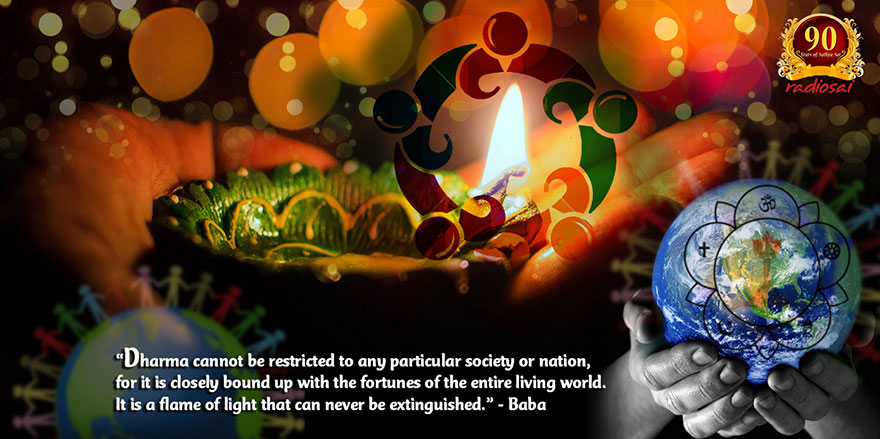 |
That was the quote I ended my last talk with. The following points emerge from that quote:
The whole of humanity, indeed every single human being is bound by Dharma. It is wrong to assume that Dharma is restricted to any country, race, community, sect, people professing any particular faith, etc.
By implication, Swami states that the Bhagavad Gita is all about Dharma. We will hear more about it later.
The third point, and this is very important, Gita and therefore Dharma are absolutely indispensable for today’s society.
Finally, Dharma is the very breath of life. In other words, life that is Adharmic is no life at all. A person whose life is characterized by constant violation of Dharma, is as good as dead.
We now come to core concepts concerning Dharma. Before I quote Swami on this rather important topic, may be I could prepare the ground by making some clarifying remarks. To start with, I should mention that where Dharma is concerned, there is a fundamental principle to start with, followed by practical considerations. When we hear this for the first time, we tend to feel rather confused, but in actual fact, there is no need for any confusion. Let me explain it this way.
Now almost all countries have a written constitution, Britain being a prominent exception. The constitution invariably defines the basics, and within these basics, the country frames laws, usually via a legislative process. Laws thus passed are called Acts, and they are supposed to be in full conformity with the constitution. Sometimes there are disputes whether the act passed by the parliament is actually in conformity with the constitution or is in violation of it. In the event of such a dispute, a case is filed before the Supreme Court which is usually the final judicial authority. The constitutional bench of the Supreme Court then decides whether the act in question is in violation of the constitution or not. This is the way the legislative process works.
 |
With this preamble, we are all set to hear what Swami says next. Watch out for two key words: The first is Atmadharma, and the second is Acharadharma or Practical Dharma. Over now to Swami:
The Atmadharma, the Divine Dharma, is what I am speaking of. Practical Dharma or Acharadharma relates to temporary matters such as day-to-day problems, physical needs, to man’s passing relationships with the objective world, etc. The very instrument of those rules, the human body, is itself not permanent; how then can these issues, all of which are related to Practical Dharma be eternal? How can their nature be described as true?
Let us try to digest what we have just heard. It all boils down to what I referred to earlier, namely, a fundamental principle and the application of that principle to practical matters. The basic principle is called Atmadharma, and it is clear that this has to be the same for all; I mean we cannot have one basic principle for one person and another basic principle for another. Thus, according to Swami, Atmadharma is the same for all, from the king to pauper; that is it, and Atmadharma cannot be changed and it is non-negotiable. Thus, we can’t have one basic principle today, another tomorrow and yet another the day after and so on. On the other hand, the practical application could well depend on situations that keep changing. For example, two hundred years ago, there was no meaning in asking the question: “Is it OK or not to travel in a train without a ticket?” There simply were no railway trains then!
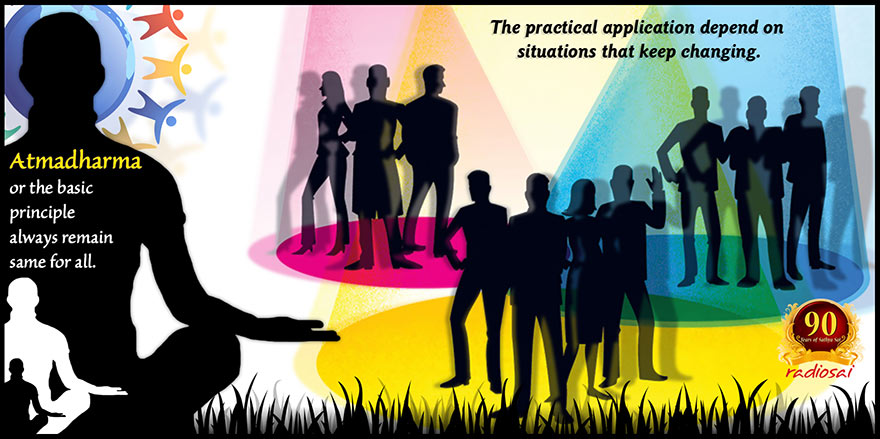 |
Hope you follow; the point is that the Basic Principle is always the same; however, in the practical application, one could continue to encounter new situations and every time one does so, one must analyse starting from first principles. So, it all boils down to: “How exactly does one apply this fundamental principle to practical and real-life situations?” There can be real sticky situations, and let me give you an example.
Let us say there is a patient who is in a coma and kept alive on a ventilator cum life support system. The patient is a vegetable, that is to say, brain-dead. The patient has been kept alive like this for years and years. Suddenly, a new patient comes, and this is an emergency. A ventilator and life support system is urgently needed for this person also, and there is none available except the one in which the brain-dead person is kept. If that is given to the second patient, he might survive and recover, and even lead a normal life. However, to provide the required facility to the second patient, the brain-dead person would have to be pulled out of the life-support system, which means that the brain-dead person would actually die immediately. So what does the doctor do?
He is caught in a real fix. The first patient sure needs the system and came there first. However, the person is brain dead, while the second person is not. That said, the second person is in a serious condition and badly needs a life-support system. Without it, the second person is dead but with it, the person could survive and even lead a normal life. So does the doctor vote for the brain-dead person who, according to medical opinion, will never wake up from the vegetable state or for the second person who might even lead a normal life? This is what is called a Moral dilemma or Dharmasangatam.
This is a real tough problem, and this is where the person has to ask sharp questions and seek the answers from the Conscience. By the way, the list of questions I gave earlier are just indicative and they would have to be tuned to each situation appropriately. In this case, the doctor concerned, who obviously would know the right questions to ask, would have to handle the situation with extreme sensitivity.
This raises the question: “What on earth is this sacred Basic Principle?” This is a fair question and a good knowledge of the Basic Principle would, in fact, help one to ask the right questions related to every situation one might encounter. So, let us turn to the Basic Principle. In other words, let us pose to ourselves the question: “What is this Atmadharma, and why is it so important?” Before I deal with that, I want you to first see the following:
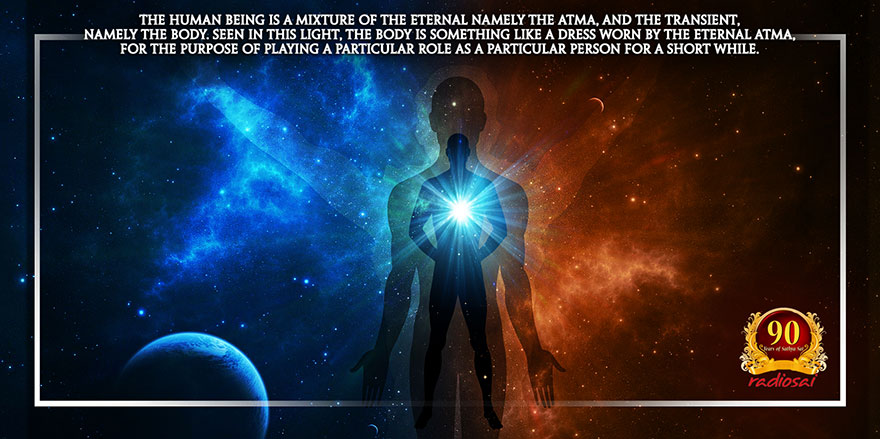 |
The Eternal cannot be expressed by the evanescent; Truth cannot reveal itself in untruth; Light cannot be procured from darkness. The Eternal can emerge only from the Eternal; Truth can emanate only from Truth. Therefore, the objective codes of Dharma relating to worldly activities and daily life, though important in their own sphere, have to be followed with the full knowledge and consciousness of the Inner Basic Atmadharma; then only can the internal and external urges co-operate and yield the Bliss of harmonious progress.
Now this is a very important quote, and I do hope you paid close attention to that. The essence of it is: Whatever be the nature of the practical action taken to meet the demands of a particular situation, it must be completely in alignment with Atmadharma.
Let us try to digest this. As Swami often reminds us, the human being is a mixture of the Eternal namely the Atma, and the transient, namely the body. Seen in this light, the body is something like a dress worn by the Eternal Atma, for the purpose of playing a particular role as a particular person for a short while.
I suppose you would not find it difficult to accept that. Now what makes the whole thing a bit more complex and also interesting is the presence of the Mind. You see, the human being is not just body plus the Atma but body plus the mind and the Atma. It is the mind that makes the whole thing a lot more complicated. Later we shall zoom in on the crucial role played by the mind. Now let us go back to the Swami's quote. He says: “The Eternal cannot be expressed by the evanescent; Truth cannot reveal itself in untruth; Light cannot be procured from darkness. The Eternal can emerge only from the Eternal; Truth can emanate only from Truth.”
What this tells us is that when an action is performed by the transient body, guided and aided perhaps by the equally transient mind, it would be like candle light at best, light that can be blown off and get extinguished. Surely, we cannot let that happen, can we? Swami wants our actions should reflect the permanent and not the transient; only then would the action be really in accordance with Truth. Why must actions be harmony with Truth? For the simple and elementary reason that Truth is God and thus also Eternal. Keeping all this in mind, let us now try and connect the dots. We have the following facts.
We may appear to have a human form but in reality, the body is a mere dress covering the Eternal and Intangible Atma. This is just another way of saying we are NOT the body but the Eternal Atma!
 |
The body is transient, and exists in a world that is itself transient.
However, though the body, the action, and the world in which the action is performed are all transient, the flavour of the action must be Eternal!
These are the dots. Now how do we connect these? This is what Swami tells us:
Now although it is the transient body that performs the action in an equally transient world, and although the action itself might have been triggered by something that happened in the world, yet, something far beyond must govern our actions.
A Basic Principle must govern our actions, and that Principle is called Atmadharma.
Atmadharma simply means action that is in full conformity with the Nature of the Atma.
What is the Nature of the Atma? In simple words, Atma is Pure Love and Limitless Compassion.
In turn, this means that to the extent possible, all actions must flow from Pure Love and a sense of Divine Compassion.
Now for many, the word Dharma is nothing new. Indeed, until recently when religion and values suddenly become unfashionable, Dharma was an accepted and even treasured value. Yet, strange as it might seem, not many really understood what exactly Dharma meant and that includes even scholars well versed in the Gita. That is why we must really consider ourselves most fortunate that Swami has come to our rescue by explaining to us what precisely Dharma means.
Let me move on. What comes through very emphatically from all that has been said thus far is that though our actions might be in this world and be guided by worldly considerations, yet the Basic Principle guiding our actions no matter what they are, must be rooted without fail in the Atmic nature of the human being.
All this might sound very strange but let us not forget that it was God as Krishna who first said so to Arjuna, five thousand years ago. And it is that same God who is repeating that very same message to us; so we really need to pause and take all this in slowly.
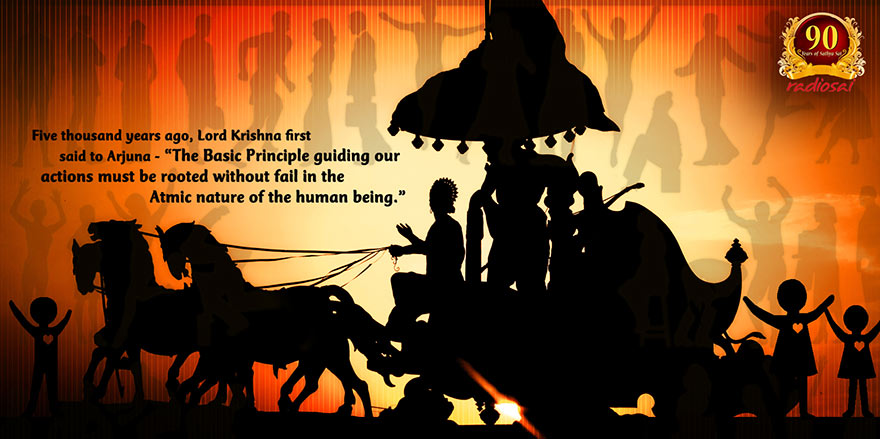 |
May be I can explain all this a bit better using an example. Recently, the issue of fake medicines and drugs has assumed alarming magnitude. Sad to say, most of the fake drugs are apparently coming from China and India. That India is involved is a matter of deep regret, considering the wonderful Dharmic tradition this country has boasted of for thousands of years. And when we remember that this is the land of Rama, Krishna, Buddha, Shirdi Baba, and of course our beloved Swami, this is absolutely shocking.
Let us set aside this painful aspect for a moment and go into the root cause for this problem. Now why are some people stooping so low as to make and market fake drugs? All for making a fast buck, as they say. The manufacturers of fake drugs argue, “What are you griping about? People are making a killing in the market all the time if they can get away with it. Is there any legitimate reason for crude oil to be as expensive as it really is? Take other commodities, like coffee, for example. People buy coffee beans at a very low price in some African countries and then sell that very same coffee at such a great price in the world market. People use cheap labour to make garments at very low cost and make huge profits by selling these. It is all a question of making profit; that is the way the market operates. Why should you be so aghast against this business? We are not compelling people to buy our products, are we?”
This is of course an ingenious kind of non-argument and yet this is the way things are. Of course, we can argue that unlike in the case of garments, carpets and so on, in the case of fake drugs, the health and indeed the life of the patient is at stake. Very true, but on the other hand, very often in the other cases like garments, for example, the labour conditions are deplorable; that is why such garment factories are called sweat shops. There, it is the labour that is being taken for a ride and cheated massively; and add to it the fact that poor working conditions often ruin the health of the workers involved. Who can say it is all Dharmic? The term 'market' does not convert Adharma into Dharma and that is what one has to be very careful about.
 |
Now let us consider the production of small arms, like machine guns and so on. There is a huge arms industry, mostly in the developed countries and they all do a thriving business in the sale of such weapons. It is argued that all this is legitimate, not forbidden by law, etc. Now cut to Africa, where millions have been killed in the last fifteen years or so, thanks to all kinds of conflicts between tribes, between countries, etc., most of the killings being gruesome. Indeed, right now, some of the people involved are being tried for genocide. People say, “Well, what’s wrong with that? These are murderers and deserve to be punished.” I am not disputing that. However, I would like to pick up another point.
Now the UN appointed a Committee to consider the entire issue of unregulated sale of small arms in huge quantities in Africa, which unquestionably aided and helped in promoting and sustaining widespread conflicts, killing, etc. The Chairman of the Committee was an African and the members included many from the developed countries. The Chairman pleaded, “You gentlemen from the rich countries, why don’t you for heaven’s sake refrain from selling your weapons in this part of the world?” The Chairman’s appeal makes eminent sense but the reps of the rich countries strongly objected, making all kinds of arguments about having their market share, etc.
These are all in the public domain and I shall not go into the details. My intention is to place all this in the context of Atmadharma. You might wonder: “What can international trade in small arms have to do with Atmadharma?” Well, that precisely is the question I am now going to deal with because that would explain why and how Atmadharma is so very important, and how it affects everything, including matters that appear to be very remote and unconnected.
Let us get back to the arms bazaar. Why do people produce guns? Because, according to them, there is a market. They simply say, “Well, there is a demand and that is why we produce.” And remember, the gun production business is largely in the affluent countries. So, they engage in arms business because it yields huge profit, However, when it comes to drugs like heroin and cocaine, since these drugs affect the affluent countries, suddenly, these merchants of death forget all about the profit motive and they say, “Look, these drugs are dangerous; they kill our young people. How can we ever tolerate them? Growing these crops is immoral and illegal, and conversion of the raw material into the final drug is utterly criminal.” The reference is here to poor countries where the plants from which heroin and cocaine are made, are grown. What about the manufacture of guns and their sale? Don’t guns kill people? Don’t they promote the recruitment of child soldiers and so on? Of course they do, but all that is swept under the rug. This is what double standards are all about.
In short, when convenient, all kinds of arguments like market demand, etc., are used for manufacturing and making products that are manifestly undesirable, ranging all the way from violent films, pornography and whatnot right up to machine guns. However, when it comes to drugs there is a different yardstick used and that is where double standards come up.
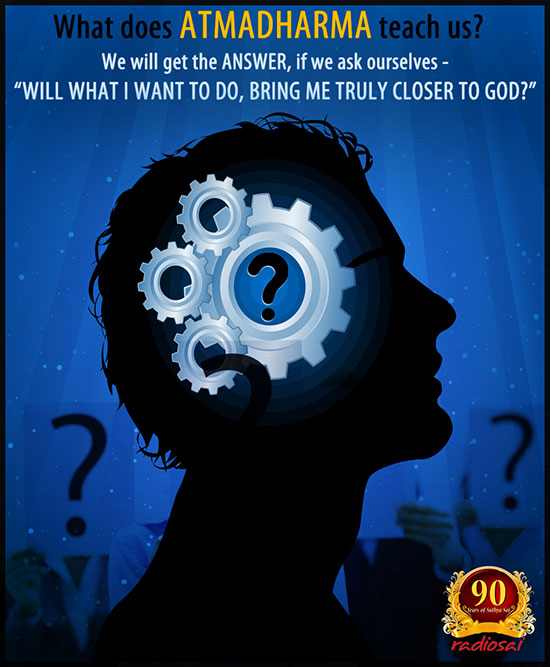 |
I do not want to appear to be partisan, favouring countries of the East as against the countries of the West. Rather, I want to look at the ENTIRE issue in the context of Atmadharma. Yes, that is right! Are you wondering what Atmadharma, which is a concept rooted in the Gita taught five thousand years ago, has to do with drugs and guns which did not exist then? You bet it does!
Let us go over this slowly! What does Atmadharma teach us? It teaches us that when we want to do anything, we should ask basic questions; I gave you earlier a sample of the kind of questions that one should ask. In this case, the relevant and most pertinent question would be, “Would the product I am making and trying to sell in the market – it could be narcotics or guns – is this based on selfishness or not? Would this product harm society in any way? Am I trying to cover up what I am trying to do under double standards? More than anything else, WILL WHAT I WANT TO DO, BRING ME TRULY CLOSER TO GOD?” Incidentally, that is the ultimate, acid test! When hard and tough questions are asked that way, there is absolutely no doubt the answer would come through loud and clear!
To repeat, Atmadharma is the guiding principle that would fine-tune our actions in such a way as to bring us closer to God. The purpose of life is to return to God – that is what Swami says and not me. If for the moment you do accept what I say about the purpose of life, then both growing poppy or making and selling guns are equally to be abhorred. One cannot make a case for just one of the two activities and condemn the other. In short, where Atmadharma is concerned, there is absolutely no room for any selfishness, and no double standards whatsoever, period! And, above all, if to God we wish to return – remember that is THE purpose of life – then Atmadharma is the compass we must always use.
May be all this leaves you a bit dazed; but don’t worry, as we go along, things would become more and more clear. There is actually a simple way of remembering all this. Just watch the actions of Swami. Do we ever see Swami do anything that has even a trace of selfishness? No! Why? Because He is the very personification of the Atma. Is it at all ever possible for any Avatar to show hatred? No! Why? Because every Avatar is a personification of the Atma. And so on it goes, when we look at the whole matter in terms of compassion, Ahimsa, Kshama, etc. That is why Swami says, “Watch Me closely, for My life is My Message!”
Now you might say: “Hey! Wait a minute!! Swami is God and so He can do all that you say! We cannot. We are mortals, we are mere humans. We are not God; are you not forgetting that?” Well, I ask in return: “Are you, dear reader, not forgetting that Swami repeatedly tells us that we also are God, and that we must rise above the so-called human level so that the Divinity latent within us gets revealed? Has He not told us that the human form has been specially given to us so that we can follow Atmadharma and redeem our lives?”
 |
In the Gita Vahini, Swami says, we all live in the world, that we act on account of worldly considerations and within parameters spelt out by society, etc. All that is true. However, the basic motivation for the action must always be based on considerations of the Eternal – no escape from that.
Well, that’s all for now. Hope you did not find that dose too heavy. Good luck and see you again next time.
Part 01 || Part 02 || Part 04 || Part 05 || Part 06
- Radio Sai Team
What do you think about this Musings? Please let us know by writing in to h2h@radiosai.org or you may leave your thoughts in the comments section. Do not forget to mention your name and country.
| comments powered by Disqus |






